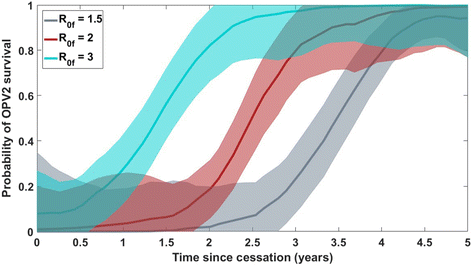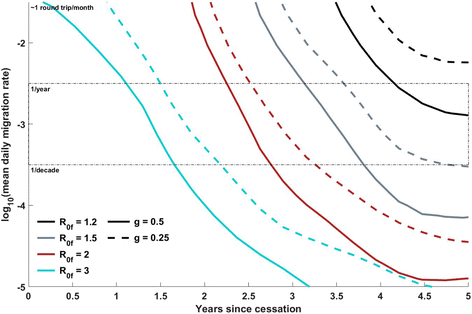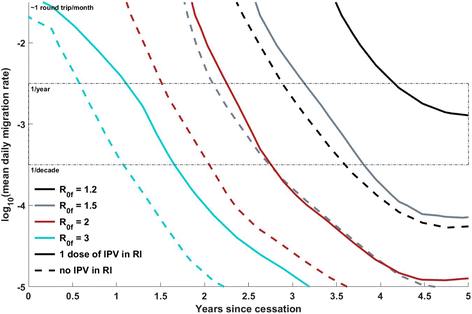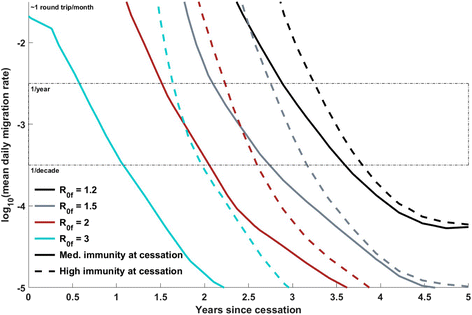The risk of type 2 oral polio vaccine use in post-cessation outbreak response
- PMID: 28974220
- PMCID: PMC5627419
- DOI: 10.1186/s12916-017-0937-y
The risk of type 2 oral polio vaccine use in post-cessation outbreak response
Abstract
Background: Wild type 2 poliovirus was last observed in 1999. The Sabin-strain oral polio vaccine type 2 (OPV2) was critical to eradication, but it is known to revert to a neurovirulent phenotype, causing vaccine-associated paralytic poliomyelitis. OPV2 is also transmissible and can establish circulating lineages, called circulating vaccine-derived polioviruses (cVDPVs), which can also cause paralytic outbreaks. Thus, in April 2016, OPV2 was removed from immunization activities worldwide. Interrupting transmission of cVDPV2 lineages that survive cessation will require OPV2 in outbreak response, which risks seeding new cVDPVs. This potential cascade of outbreak responses seeding VDPVs, necessitating further outbreak responses, presents a critical risk to the OPV2 cessation effort.
Methods: The EMOD individual-based disease transmission model was used to investigate OPV2 use in outbreak response post-cessation in West African populations. A hypothetical outbreak response in northwest Nigeria is modeled, and a cVDPV2 lineage is considered established if the Sabin strain escapes the response region and continues circulating 9 months post-response. The probability of this event was investigated in a variety of possible scenarios.
Results: Under a broad range of scenarios, the probability that widespread OPV2 use in outbreak response (~2 million doses) establishes new cVDPV2 lineages in this model may exceed 50% as soon as 18 months or as late as 4 years post-cessation.
Conclusions: The risk of a cycle in which outbreak responses seed new cVDPV2 lineages suggests that OPV2 use should be managed carefully as time from cessation increases. It is unclear whether this risk can be mitigated in the long term, as mucosal immunity against type 2 poliovirus declines globally. Therefore, current programmatic strategies should aim to minimize the possibility that continued OPV2 use will be necessary in future years: conducting rapid and aggressive outbreak responses where cVDPV2 lineages are discovered, maintaining high-quality surveillance in all high-risk settings, strengthening the use of the inactivated polio vaccine as a booster in the OPV2-exposed and in routine immunization, and gaining access to currently inaccessible areas of the world to conduct surveillance.
Keywords: Cessation; Eradication; Oral polio vaccine; Poliovirus; Vaccine-derived poliovirus.
Conflict of interest statement
Ethics approval and consent to participate
Permission for access to the POLIS case and campaign databases and the use of WHO shapefiles was granted to the Institute for Disease Modeling researchers through the World Health Organization.
Consent for publication
Not applicable.
Competing interests
The authors declare that they have no competing interests.
Publisher’s Note
Springer Nature remains neutral with regard to jurisdictional claims in published maps and institutional affiliations.
Figures





Comment in
-
Models and analyses to understand threats to polio eradication.BMC Med. 2017 Dec 22;15(1):221. doi: 10.1186/s12916-017-0991-5. BMC Med. 2017. PMID: 29268738 Free PMC article.
References
-
- Garon J, Seib K, Orenstein WA, Gonzalez AR, Blanc DC, Zaffran M, Patel M. Polio endgame: the global switch from tOPV to bOPV. Expert Review of Vaccines. 2016;15(6):693–708. - PubMed
-
- World Health Organization. Global eradication of wild poliovirus type 2 declared. 2015. https://web.archive.org/web/20160802182045/http://www.polioeradication.org/mediaroom/newsstories/Global-eradication.... Accessed 2 Aug 2016.
MeSH terms
Substances
LinkOut - more resources
Full Text Sources
Other Literature Sources
Medical
Miscellaneous

